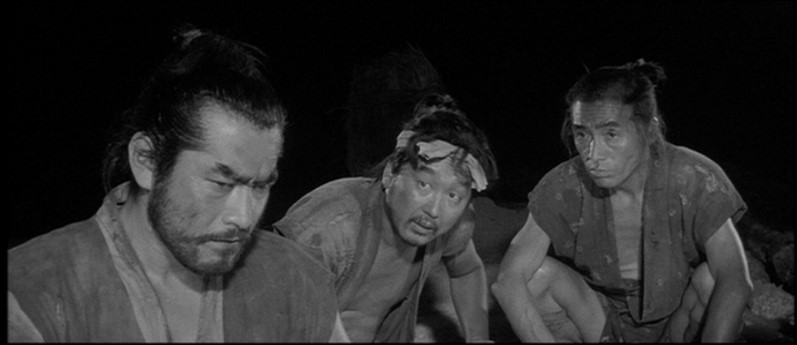Sunday, January 28, 2007
The Hidden Fortress
Jeff GP, NEW YORK CITY
January 19, 2007 - DVD/Landmark Sunshine Cinema
A pair of squabbling bickering best buddies end up stranded in a desert after an enemy pursuit. In a moment of frustration the two separate, only to be captured and reunited. These buddies are Tahei (Minoru Chiaki) and Matakichi (Kamatari Fujiwara), and more than enough have been written about how their Rosencrantz and Guildenstern-ish presence in this picture resembles that of R2-D2 and C-3PO in Star Wars. Some people venture into complete inanity and refer to Star Wars as a remake of The Hidden Fortress. That is not true. This opening scene no doubt meshes with the opening of Star Wars and George Lucas’ movie even takes specific visual and aural cues from The Hidden Fortress, but referring to it as a remake is about as helpful as referring to Boogie Nights as a remake of Raging Bull (meaning not helpful at all). So, to get that out of the way, Star Wars does not sneakily and unjustly remake The Hidden Fortress and not give credit where credit is due. As I initially indicated, having a pair of “fools” to push a story forward is not something Akira Kurosawa nor George Lucas invented, but it is something they used to magnificent effect in producing fun, beautiful, easily digestible fantasy (historical or interstellar) that would influence countless storytellers for ages.
Tahei and Matakichi, tempted by royal riches, end up embroiled in the high-stakes exodus of Princess Yuki (Misa Uehara) from dangerous to safe territory. Her protector is arguably the most charismatic action star in the history of moving pictures, Toshiro Mifune, playing arguably the most skilled fighter in Japan, General Rokurota Makabe. The simplicity of this road actioner is not to be underestimated. It is simple, but this simplicity, matched with good-humored colorful characters and performances, stellar action sequences and beautiful black-and-white landscapes foretell the brilliance that would come from Hollywood’s greatest action pictures and directors (Steven Spielberg and James Cameron to name two).
Along with that Hollywood influence comes the similar trappings that make these Hollywood pictures somewhat disconcerting. In The Hidden Fortress, comic relief Tahai and Matakichi bumble through masses of peasants, many of which are getting shot and killed. Bodies are falling left and right, and it’s played for laughs as the two buddies goofily avoid getting killed.
With all of those corpses aside, and the violence presented as wholly unreal and unaffecting, the flood of humanity is quite striking in contrast with the deserted landscape that occupies most of the movie. For pieces The Hidden Fortress plays and looks the part of a big-budget adventure with expensive expansive sets and tons of extras, but when the gang is not in a town or urban center, they are alone in a tiny-budgeted human comedy. The city limits stop and there is nothing. They wander the countryside unmolested and alone with the landscape. The prospect of a very small outlying community seems impossible. With the exception of a scene where a few mounted troops give them some trouble, the motley band must avoid groups that seem to travel no less than 100 people to a group. The interplay between the personal and epic scope is what would go on to define the great Hollywood yarns of the future. The personal, small nature of movies such as Raiders of the Lost Ark, Lawrence of Arabia and Lord of the Rings is what makes them true successes, not only the action. It is a simple formula, but very difficult to manage well. Akira Kurosawa was one of the early pioneers of such thought, and in turn made movies as fun as they can be. The Hidden Fortress is the least serious I’ve seen Kurosawa be, and the most playful and fun.
A final note:
Big action, big personalities, fantastic music and glorious black and white vistas look detailed and magical when projected on 35mm. Why then, and how dare they, charge full regular admission at the Landmark Sunshine for a screening of The Hidden Fortress on DVD? Nothing is classier than a movie starting with a DVD menu. Fuck you Landmark. If you can’t get a print, why even book it? What’s your problem?
Posted by
Jeff GP
at
3:40 PM
![]()
Labels: Akira Kurosawa, Armond White, Boogie Nights, DVD, George Lucas, Landmark Sunshine, Raging Bull, Rosencrantz and Guildenstern, Star Wars, The Hidden Fortress, Toshiro Mifune
Subscribe to:
Post Comments (Atom)



3 comments:
When was this movie made?
1958, Margaret.
Are you serious, GP? Ugh. I felt insulted enough watching Saraband on DVD at various Landmark theaters... why did they even show this movie?
Now, hold it you rascals... Agreed, this is bad form all over, but in Saraband's case-- at some of those theaters-- it was either show the DVD or don't show it at all. And as irritating as DVD projection is, wouldn't you rather watch the thing with a bunch of Kurasawa dorkuses than at home?
Charging full price is beyond the limit, though. You should have asked to own 1/3 of the DVD.
Post a Comment